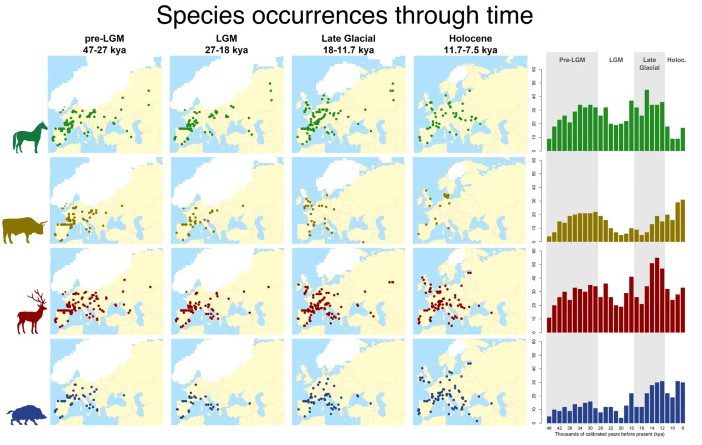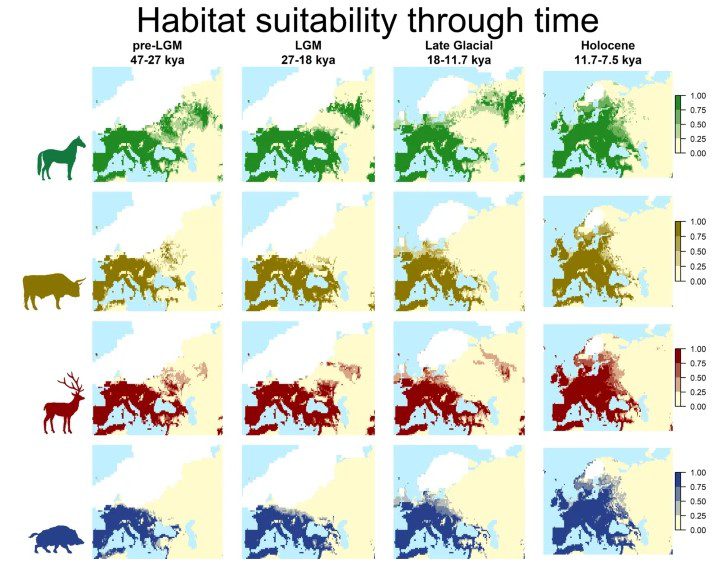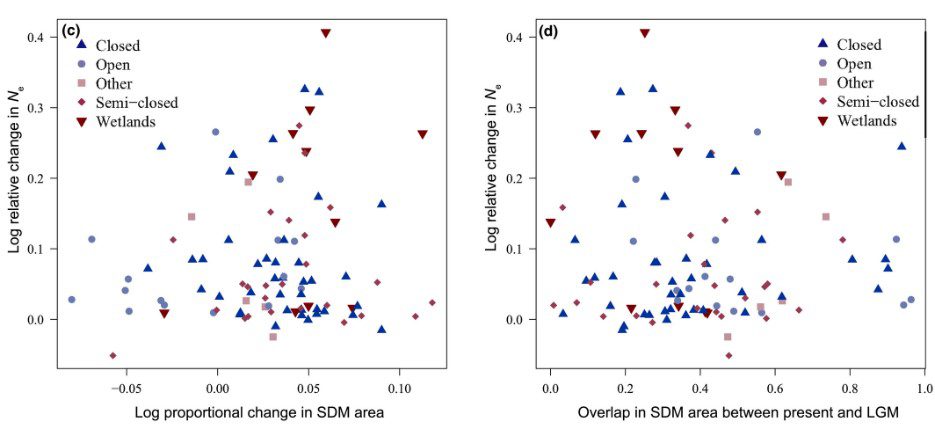È uscito nella rivista “Communications biology” l’articolo che abbiamo scritto con Andrea Manica (Cambridge), Francesco Boschin e Paolo Boscato (Siena).
Michela Leonardi, Francesco Boschin, Paolo Boscato & Andrea Manica
Following the niche: the differential impact of the last glacial maximum on four European ungulates
Communications Biology volume 5, Article number: 1038 (2022)
Cosa è successo agli ungulati temperati in Europa durante le fluttuazioni climatiche che hanno interessato gli ultimi 50.000 anni? Per rispondere a questa domanda abbiamo raccolto un database di date al radiocarbonio associate a resti di cavallo, uro, cervo e cinghiale tra 47.000 e 7.500 anni fa (in modo da escludere individui domestici).

Abbiamo analizzato questi dati con un nuovo metodo che ricostruisce la nicchia ecologica (realizzata) nel tempo, e permette di testare se è rimasta stabile o è cambiata. Tutte le specie analizzate hanno cambiato la loro nicchia, principalmente durante l’ultimo massimo glaciale o subito dopo, con uno schema coerente con le preferenze individuali in termini di habitat. Sembra che siano sopravvissuti ai cambiamenti climatici grazie alla loro flessibilità e all’espansione della loro nicchia in risposta all’estinzione di altre specie animali avvenute i quel periodo (sia competitori, sia predatori).

In termini più generali, con questo studio dimostriamo che anche specie grandi, con tempi di generazione lunghi, possono cambiare la loro nicchia nel corso di poche migliaia di anni. Questo deve suggerire estrema cautela quando si assume che la nicchia ecologica rimanga costante sia quando si ricostruisce il passato sia quando si prevede il futuro.
E se siete arrivati a leggere fino a qui, ecco una piccola sorpresa per premiarvi dell’impegno!
Articolo
Michela Leonardi, Francesco Boschin, Paolo Boscato & Andrea Manica
Following the niche: the differential impact of the last glacial maximum on four European ungulates
Communications Biology volume 5, Article number: 1038 (2022) DOI: 10.1038/s42003-022-03993-7
Abstract
Predicting the effects of future global changes on species requires a better understanding of the ecological niche dynamics in response to climate; the large climatic fluctuations of the last 50,000 years can be used as a natural experiment to that aim. Here we test whether the realized niche of horse, aurochs, red deer, and wild boar changed between 47,000 and 7500 years ago using paleoecological modelling over an extensive archaeological database. We show that they all changed their niche, with species-specific responses to climate fluctuations. We also suggest that they survived the climatic turnovers thanks to their flexibility and by expanding their niche in response to the extinction of competitors and predators. Irrespective of the mechanism behind such processes, the fact that species with long generation times can change their niche over thousands of years cautions against assuming it to stay constant both when reconstructing the past and predicting the future.



